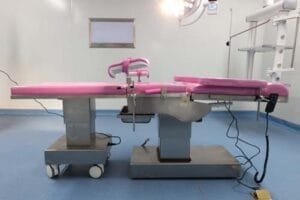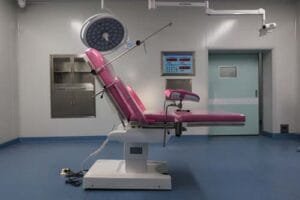Adresse
304, rue Cardinal Nord
Centre Dorchester, MA 02124
Heures de travail
Du lundi au vendredi : 7h - 19h
Week-end : 10h - 17h
La sécurité des femmes enceintes et des nouveau-nés est primordiale dans le domaine de la santé, notamment lors de l'accouchement. Les tables d'accouchement électriques sont devenues incontournables dans les soins de maternité modernes, offrant des fonctionnalités et une technologie de pointe pour améliorer l'expérience de l'accouchement. Dans ce guide complet, nous explorerons les aspects sécuritaires des tables d'accouchement électriques, répondrons aux préoccupations et mettrons en lumière leur rôle dans le bien-être des mères et des bébés.
L'introduction des tables d'accouchement électriques dans les maternités a profondément transformé la prise en charge des accouchements. Ces tables sont dotées de fonctionnalités avancées visant à améliorer la sécurité et le confort des futures mamans. Cependant, une question essentielle demeure : les tables d'accouchement électriques sont-elles sûres pour les mères et les bébés ?

Une table d'accouchement électrique est un dispositif médical spécialisé conçu pour accompagner les femmes enceintes pendant le travail et l'accouchement. Elle est équipée de commandes motorisées permettant des réglages précis du positionnement et du confort. Ces tables sont une évolution des alternatives manuelles traditionnelles et offrent de nombreux avantages.
L'introduction des tables d'accouchement électriques représente une étape cruciale dans l'évolution des soins de maternité. Les maternités sont passées d'une utilisation exclusive de tables manuelles à l'adoption de solutions technologiques. Cette évolution est motivée par la volonté d'améliorer la sécurité, l'efficacité et l'expérience globale de l'accouchement.
Les tables d'accouchement électriques sont conçues avec de multiples fonctions de sécurité pour assurer le bien-être des mères et des bébés.
L'un des principaux dispositifs de sécurité est la présence de mécanismes de verrouillage. Ces mécanismes empêchent tout mouvement involontaire de la table pendant les interventions, garantissant ainsi la stabilité de la future maman.
Les tables d'accouchement électriques sont conçues avec des limites de charge pour garantir un soutien sûr de la future maman. Cette caractéristique réduit le risque de surcharge de la table, source d'accidents.
En cas d'urgence, la table d'accouchement électrique est équipée d'un bouton d'arrêt d'urgence. Cette fonction permet aux soignants d'interrompre rapidement le mouvement de la table, prévenant ainsi tout risque de blessure pour la mère ou le bébé.
L’adoption de tables d’accouchement électriques dans les maternités offre plusieurs avantages, contribuant à la sécurité et au bien-être des mères et des bébés.
Les tables d'accouchement électriques offrent un positionnement précis pendant l'accouchement. Cette fonctionnalité réduit considérablement les risques de complications et assure la sécurité de la mère et du bébé.
Le confort de la future maman est une priorité lors de l'accouchement. Les tables d'accouchement électriques sont dotées de surfaces rembourrées, d'un design ergonomique et de composants réglables qui améliorent le confort de la patiente tout au long de l'accouchement.
Les tables d'accouchement électriques sont polyvalentes et s'adaptent à divers scénarios de soins de maternité. Elles peuvent être utilisées pour les examens, les accouchements et même les interventions chirurgicales si nécessaire, ce qui en fait des atouts précieux dans les établissements de santé.

Bien que les tables d’accouchement électriques offrent de nombreux avantages, il existe également des considérations et des risques potentiels dont les établissements de santé doivent être conscients.
Un entretien et une formation appropriés sont essentiels pour une utilisation sûre et efficace des tables d'accouchement électriques. Un entretien régulier garantit le bon fonctionnement des dispositifs de sécurité, et la formation du personnel est essentielle pour une utilisation correcte de ces tables.
Les coûts d'acquisition et d'entretien des tables d'accouchement électriques doivent être pris en compte dans le budget des établissements de santé. Si ces tables offrent des avantages, elles nécessitent également un investissement financier.
Des études scientifiques et des données de sécurité soutiennent l'utilisation de tables d'accouchement électriques en maternité. Des recherches ont montré que ces tables contribuent à des accouchements plus sûrs et plus confortables, avec des risques associés minimes.
Oui, les tables d'accouchement électriques sont conçues avec de multiples dispositifs de sécurité, notamment des mécanismes de verrouillage, des limites de capacité de poids et des fonctions d'arrêt d'urgence, pour assurer la sécurité des mères et des bébés pendant l'accouchement.
Les tables d'accouchement électriques sont principalement destinées aux établissements de santé et aux hôpitaux, où elles sont intégrées aux protocoles standards des soins de maternité.
Si les tables d'accouchement électriques offrent de nombreux avantages, un entretien adéquat et une formation adéquate du personnel sont essentiels pour atténuer les risques potentiels. De plus, les établissements de santé doivent tenir compte de l'investissement financier nécessaire à l'acquisition et à l'entretien de ces tables.
En conclusion, les tables d'accouchement électriques font désormais partie intégrante des soins de maternité modernes, contribuant à la sécurité et au bien-être des mères et des bébés pendant l'accouchement. Leurs dispositifs de sécurité avancés, leur positionnement précis et le confort accru des patientes font de ces tables des atouts précieux dans les établissements de santé. Les établissements de santé qui envisagent d'adopter des tables d'accouchement électriques doivent privilégier un entretien adéquat, la formation du personnel et une planification budgétaire afin d'optimiser leurs avantages tout en garantissant la sécurité.
